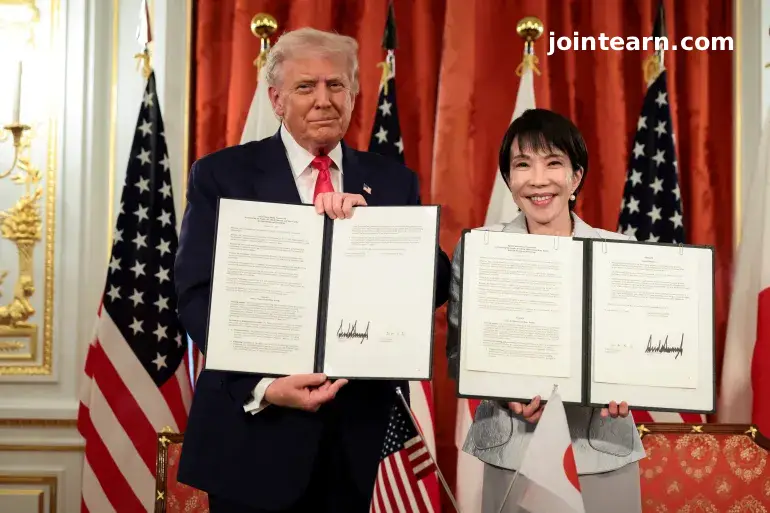
Tokyo, Japan — October 28, 2025 — In a historic meeting at Tokyo’s Akasaka Palace, United States President Donald Trump and Japanese Prime Minister Sanae Takaichi signed a major bilateral agreement to secure the global supply of rare earth minerals and other critical resources vital to modern technology, energy, and defense industries.
The pact, which underscores growing strategic cooperation between Washington and Tokyo, comes as both nations seek to reduce dependence on China’s dominance in rare earth processing and manufacturing.
Strengthening US–Japan Strategic Partnership
The meeting marks Trump’s first visit to Japan since his return to office and the first high-level summit with Japan’s first female prime minister, Sanae Takaichi. During the bilateral talks, the two leaders finalized a framework to enhance supply chain resilience, bolster trade in critical minerals, and increase defense and energy cooperation.
“It’s a very strong handshake,” Trump said during their photo session, praising Takaichi’s leadership and historic rise. “Everything I know from Shinzo [Abe] and others, you will be one of the great prime ministers. I’d also like to congratulate you on being Japan’s first woman prime minister. It’s a big deal.”
Takaichi, a long-time ally of late Prime Minister Shinzo Abe, reciprocated the praise and pledged Japan’s full commitment to regional stability and partnership with the US. She also said she plans to nominate Trump for the Nobel Peace Prize, citing his efforts in mediating ceasefires in global conflict zones.
Rare Earths and Critical Minerals: A New Strategic Frontier
At the heart of the summit was the US–Japan Critical Minerals and Rare Earths Supply Chain Agreement, which aims to secure essential materials used in smartphones, electric vehicles, fighter jets, and renewable energy systems.
According to a White House statement, the deal will “assist both countries in achieving resilience and security of critical minerals and rare earths supply chains” while identifying joint projects to close supply gaps. The initiative covers resources such as permanent magnets, lithium batteries, catalysts, and optical materials.
The move follows growing concerns in Washington and Tokyo over China’s control of nearly 90 percent of the global rare earth processing market. Both nations have pledged to invest in alternative sources and refining technologies to ensure stable, transparent, and sustainable supplies.
Expanding Economic and Military Ties
In addition to the rare earths agreement, Takaichi reaffirmed Japan’s plan to increase defense spending to 2 percent of its GDP, accelerating a military buildup aimed at countering regional threats from China and North Korea.
Sources close to the discussions told Reuters that Tokyo is also preparing a $550 billion investment package that includes shipbuilding contracts, expanded purchases of US natural gas, soybeans, and pickup trucks, and potential collaboration on clean energy and semiconductor production.
Trump, in turn, praised Japan’s economic support and commitment to strengthening the alliance. “Japan has always been one of America’s strongest friends and most reliable partners,” he said. “This agreement takes our relationship to a new level of security and prosperity.”
The meeting concluded with an exchange of gifts — including a gold-leaf golf ball and a signed golf bag from Japanese champion Hideki Matsuyama, presented by Takaichi in memory of Shinzo Abe’s friendship with Trump.
Regional Implications and Next Steps
After the Tokyo summit, Trump and Takaichi are expected to visit the US naval base in Yokosuka, home to the USS George Washington aircraft carrier, reinforcing the alliance’s military dimension. Trump will then travel to South Korea for further talks with Chinese President Xi Jinping, aiming to de-escalate ongoing US–China trade tensions.
Analysts say the Tokyo deal signals a turning point in US–Asia economic and security strategy, positioning Japan as a key player in the diversification of global supply chains.
“Japan is emerging as Washington’s most reliable partner in building resilient, non-Chinese supply chains for critical minerals,” said Dr. Kenji Yamamoto, a trade policy expert at the University of Tokyo. “This is not just a trade pact — it’s a geopolitical alignment built on resource security.”
Background: Why Rare Earths Matter
Rare earth minerals — including neodymium, dysprosium, and yttrium — are indispensable for electric vehicles, wind turbines, advanced batteries, and missile guidance systems. Their production and processing have been dominated by China for decades, giving Beijing leverage over global industries.
By partnering with Japan, the US aims to counter supply risks, foster technological cooperation, and ensure long-term access to these materials for defense and innovation. The new agreement builds upon earlier collaborations under the Indo-Pacific Economic Framework (IPEF) and the Quad alliance, which includes India and Australia.
A New Era for Japan’s Leadership
For Prime Minister Sanae Takaichi, this agreement marks her first major foreign policy achievement since taking office. Known for her conservative views and strong national security stance, Takaichi has pledged to continue Abe’s vision of a “Free and Open Indo-Pacific.”
“She’s a strong, smart leader,” Trump said during the press event. “Japan and the United States are leading the way in ensuring freedom, security, and prosperity across the Pacific.”


Leave a Reply